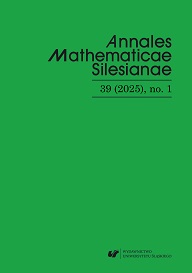

We prove a new irreducibility criterion for certain septinomials in ℤ[x], and we use this result to construct infinite families of reciprocal septinomials of degree 2n3 that are monogenic for all n ≥ 1.
Download files
Citation rules
Licence

This work is licensed under a Creative Commons Attribution 4.0 International License.
The Copyright Holders of the submitted text are the Author and the Journal. The Reader is granted the right to use the pdf documents under the provisions of the Creative Commons 4.0 International License: Attribution (CC BY). The user can copy and redistribute the material in any medium or format and remix, transform, and build upon the material for any purpose.
You may also start an advanced similarity search for this article.

Vol. 39 No. 1 (2025)
Published: 2025-03-31
 10.2478/amsil
10.2478/amsil